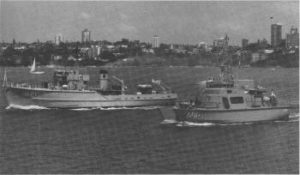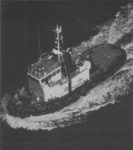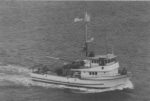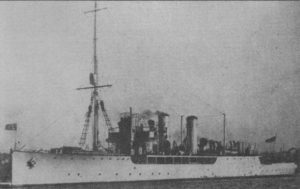- Author
- A.N. Other and NHSA Webmaster
- Subjects
- Ship design and development
- Tags
-
- RAN Ships
- HMAS Shoalwater, HMAS Gull, HMAS Snipe, HMAS Ibis, HMAS Fremantle I, HMAS Tolga, HMAS Durraween, HMAS Curlew, MSA Wallaroo, MSA Bandicoot, MSA Salvatore V, MSA Koraaga, HMAS Orara, HMAS Waterhen, HMAS Colac, HMAS Doomba, HMAS Castlemaine, HMAS Geranium, HMAS Marguerite, HMAS Mallow, HMAS Rushcutter, HMAS Warrnambool I, HMAS Swan II, HMAS Bungaree, HMAS Yarra II, HMAS Whyalla I, HMAS Teal, HMAS Hawk
- Publication
- September 1993 edition of the Naval Historical Review (all rights reserved)

Catamarans And Auxiliaries
The Royal Australian Navy’s Mine Warfare vessels are based at H.M.A.S. Waterhen in Sydney Harbour, which provides homeport facilities to six mine warfare vessels, two landing craft, a patrol boat, a trials and safety ship, three support craft and a Mine Clearance Diving Team.
The ability to successfully locate and then destroy enemy mines at sea is an important role and requirement of all modern navies. To enable it to achieve its mine countermeasures functions the Royal Australian Navy has, since 1986-87, commissioned two Bay class fibreglass reinforced plastic catamarans, H.M.A. Ships RUSHCUTTER and SHOALWATER. The two MHCATs both carry a pair of remote controlled mine disposal vehicles, the PAP 104, which are used to identify and then destroy mines by placing an explosive charge next to the offending weapon. Minehunters need to be sufficiently silent in their operations, so as to not activate magnetic or acoustic mines.
Each of the catamaran’s hulls is three metres in width with an additional three metres between the two hulls. Top speed is ten knots with a range of 1200 nautical miles. Power for each vessel is provided by two diesel engines, driving two independent propulsion and steering units.

To provide a supporting force to the purpose-built Bay class catamarans the RAN recently acquired the auxiliary minesweepers (AMSs), BANDICOOT and WALLAROO in August 1990. Built in Singapore as tugs in 1982, the 242 tonne vessels were outfitted as large auxiliary minesweepers to tow influence and mechanical sweeps. Top speed is ten knots with a range of 6300 miles.

Two additional small auxiliary minesweepers, SALVATORE V and KORAAGA, were acquired as part of the Craft of Opportunity Programme (COOP) in February 1988 and February 1989 respectively. Both vessels can tow a magnetic body and acoustic noise makers for influence sweeping, a wire sweep for moored mines and a side scan sonar for surveillance.
Genesis Of The Service – The First Minesweepers
The laying of mines in local waters by the German raider WOLF during the latter years of the Great War necessitated the requisitioning from local concerns of three tugboats plus a trio of Castle class trawlers from the New South Wales Government. Most of the vessels swept along the N.S.W. and Victorian coasts, netting more than twelve mines.

During their naval service the trawlers, BROLGA, GUNUNDAAL and KORAAGA were manned by the Naval Brigade and with the tugs resumed their mercantile careers in 1919.

The first purpose built minesweeper to operate in Australian waters were the Flower class sloops, H.M.A. Ships GERANIUM, MALLOW and MARGUERITE, acquired from the Royal Navy as part of the “Gift Fleet” in 1919. After clearing the mines laid by the WOLF, all were decommissioned on 18 October. Their subsequent RAN service included survey and reserve training duties, with most sweeping gear removed. During her years as a survey ship, GERANIUM also operated a seaplane, flown from aft of the mainmast.
The Flower class all ended their days, scuttled, off Sydney in 1935.
Requisitioned For War – Second World War
For the Navy at war from September 1939, the need for suitable minesweeping vessels for the Senior Service was initially met through the requisitioning from the private trade of some 35 auxiliary minesweepers.
Conversions of trawlers, coasters, colliers and steamers was begun by a variety of local yards, each craft being fitted with suitable sweeping gear plus a defensive armament of guns and depth charges. Minesweeping groups were formed from November 1939, the first comprising the sloops H.M.A. Ships YARRA and SWAN with the auxiliaries, H.M.A. Ships DOOMBA and ORARA. Others were based at Sydney, Melbourne, Hobart, Port Adelaide, Fremantle, Darwin, Brisbane and Newcastle.




